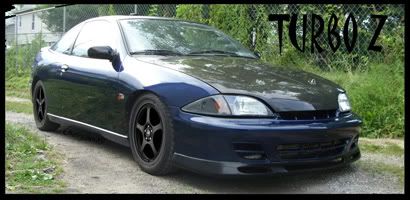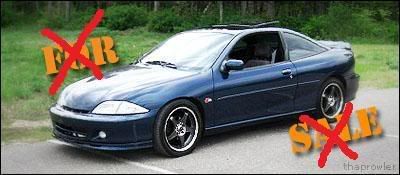I'm trying to figure out if a 50/50 mix would be ok for varioius sensors like an IAT and MAP sensors? My dillema is that I want the car to "see" the lower charge temps, so I want to spray before the IAT. This is a turbocharged application by the way. I'm not looking to inject a very large volume of the mix like some, just enough to keep consistently low charge temps. Added octane and cylinder cooling will be extra perks if they happen...

Overtime any mix can cause the tb sensors to get "wet" and damage them, which is why many opt to tap a tb spacer or somewhere post tb. Some have ran water injection for thousands of miles with no problems with the sensors, then others (including myself) it has damaged them.

No It is not a good idea. I understand exactly what you hope to accomplish and I think if you really want to do it a small shot of nitrous is the answer. It would do a much better job of cooling.

FORGET GIRLS GONE WILD WE HAVE GOVERNMENT SPENDING GONE WILD!
But a small shot of nitrous would lean out the mixture, where as a small "shot" of water/methanol would slightly richen it. This is a safety issue for me.
To be honest, this is for my GXP. The car has an aggressive IAT vs Load vs timing table, and it would be nice to stay on the cool side even during summer. The car starts pulling timing at about 100*F IAT, and adds below about 50*F IAT. If the car still sees the higher charge temps (spraying post TB, or at least post IAT), it will pull timing even though the charge is cooled significantly. I would plan to have the spray activate at a boost threshold of about 10PSI, so atomization should not be a problem with a small shot. I do realize that spraying closer to the engine will aid cylinder cooling effects, but that's not really my goal.
Anyways, thats the background behind why I ask if it damages sensors. Thanks for the input so far...

Everyone who has a supercharger sprays meth before the IAT, the IAT is in the manifold, lol. Same with the MAP sensor.
2001 Olds Alero (LD9)
650 whp / 543 ft-lb
@turboalero
Unless you have tuned it chances are it runs slightly rich as is. So if you have a wideband you can see exactly how much spraying nitrous would lean it out and could adjust the shot accordingly.
Another idea I thought of is you could do an intercooler spray bar setup. Or you could always just keep a spray bottle handy and spray the intercooler with water in between runs although not as effective it is an idea. Keep in mind I have no idea how hot your intercooler gets or how much it will help.

FORGET GIRLS GONE WILD WE HAVE GOVERNMENT SPENDING GONE WILD!
[ion wrote: C2]Everyone who has a supercharger sprays meth before the IAT, the IAT is in the manifold, lol. Same with the MAP sensor.
This is correct but we don't spray it before the IAC and TPS. It will cause chaos if the TPS gets wet. But since he is refering to this for his GXP I am not sure how it comes into play with the electronic throttle setup.
Another problem with spraying further from the engine I wanted to mention was that the water will not all get sucked into the engine. There will be little water droplets on the wall of every tube and in every crevice on the way into the engine. All these water droplets will get sucked in at some point in time but it might be at idle. Not spraying until near max boost and using one size smaller nozzle than normally recomended will help it better atomize as he mentioned. I guess the question is will it be OK over a long period of time if you are only spraying a little bit..
Edited 1 time(s). Last edited Thursday, February 26, 2009 8:05 AM

FORGET GIRLS GONE WILD WE HAVE GOVERNMENT SPENDING GONE WILD!
Thanks guys. I guess I should have mentioned more about the GXP system. It has a factory wideband and the fueling under load takes feedback from the wideband, so you (almost) always get the commanded AFR.
I want to spray on the cold side of the intercooler piping just after the intercooler outlet - the t-map is a ways up the line from that. Also, if I spray right after the intercooler, water droplets would sink (by gravity i hope) to the bottom of the charge pipe since there is a bend that goes verticle from the intercooler to the TB. I could get some puddling there i guess.
I didn't even think of the supercharger scenario - your right they are spraying all over that T-map. I think I'm talking myself into this

I'm going to contact some of the vendors to get their opinions.

Wade Jarvis wrote:It will cause chaos if the TPS gets wet.
How does the mixture reach the potentiometer on the bottom of the throttle body? It's not even exposed to the airflow area. The shaft that the butterfly plate attaches to is what moves a piece inside the TPS.

The IAC valve even is just a rubber plunger on a stick. It is just a motor that opens and closes a tiny airway passage to adjust idle, it never "senses" anything in itself, just moves depending on what the PCM tells it to.
There are no sensors that are exposed at the throttle body that could be harmed by spraying a methanol mixture through it. I intend on temporarily setting up my methanol injection next week in my intake piping just before the throttle body, until my spacer made for the MP62 comes in, which I'll tap for the nozzle post-TB.
2001 Olds Alero (LD9)
650 whp / 543 ft-lb
@turboalero
NO2 and water injection aren't comparable. NO2 is an oxidizer and requires additional fuel. A small amount of water can absorb a huge amount of heat without requiring additional fuel. When done right, it pretty much eliminates knock and you can run high compression or a turbo on plain 87 octane fuel.
2002 Cavalier 2200 5spd
[ion wrote: C2]Wade Jarvis wrote:It will cause chaos if the TPS gets wet.
How does the mixture reach the potentiometer on the bottom of the throttle body? It's not even exposed to the airflow area. The shaft that the butterfly plate attaches to is what moves a piece inside the TPS.

The IAC valve even is just a rubber plunger on a stick. It is just a motor that opens and closes a tiny airway passage to adjust idle, it never "senses" anything in itself, just moves depending on what the PCM tells it to.
There are no sensors that are exposed at the throttle body that could be harmed by spraying a methanol mixture through it. I intend on temporarily setting up my methanol injection next week in my intake piping just before the throttle body, until my spacer made for the MP62 comes in, which I'll tap for the nozzle post-TB.
A) You don't know WTF you are talking about as it relates to the TPS so STFU and stop trying to make it sound like I don't know my @!#$.
B) Your headstong, know-it-all, erogance will be your own worst enemy here. Because of this attitude of yours I really do wish the problems of dealing with a wet TPS on you.
Many of us M45 guys with pre throttle body water injection have had the problems with a wet TPS. There is a reason we put the nozzle in a throttle body spacer.
You see the throttle body is rotated 90 degrees when you bolt it onto the m45. When bolted to the m45 the TPS is now at the bottom of the throttle body. As you said the TPS is turned by the end of the butterfly shaft which is now sitting straight up and down. Yes there is a seal there where the shaft protrudes. It does not matter water will still leak past it straight down into the TPS. This is not a "theory" of mine. It is a proven fact. Infact I would love the oppertunity to rub your nose in my wet TPS like a dog that just shtt on the carpet maybe then you would get it through your thick skull that water leaks past that seal. I have dealt with this issue, by that I mean taken off my throttle body, unscrewed the TPS and poured water out of my TPS sensor. Then I took a hair dryer to it to get any remaining moisture out. I have been there done that. All you have done is talk about what you are going to do and make a decision based off what you see in your picture
Now quit spreading incorrect informatioton. I don't have time to sit here and correct it.

FORGET GIRLS GONE WILD WE HAVE GOVERNMENT SPENDING GONE WILD!
Quote:
How does the mixture reach the potentiometer on the bottom of the throttle body? It's not even exposed to the airflow area. The shaft that the butterfly plate attaches to is what moves a piece inside the TPS.
The pressurized air/water mix will find its way out though the tiniest holes. You don't have the benefit of atmospheric pressure on the other side of the throttle plate anymore.
2002 Cavalier 2200 5spd









